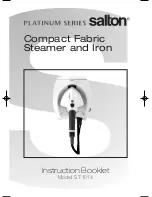
6
Vacuuming Dry Materials
1. The filter must always be in the correct
position at all times to avoid leaks and
possible damage to the Vac.
2. When using your Vac to pick up very
fine dust, it will be necessary for you
to empty the drum and clean the filter
at more frequent intervals to maintain
peak Vac performance.
NOTE:
A dry filter must be used to pick up
dry material. If you use your Vac to pick
up dust when the filter is wet, the filter will
clog quickly and be very difficult to clean.
Vacuuming Liquids
1. When picking up small amounts of
liquid (less than 3-5 cm of liquid in the
bottom of the drum) the filter may be
left in place.
2. When picking up larger amounts of
liquid (more than 5 cm of liquid in the
bottom of the drum) we recommend
removing the filter. If the filter is not
removed, it will become saturated and
misting may appear in the exhaust.
3. When the liquid in the drum reaches
a predetermined level, the float
mechanism will rise automatically to cut
off air-flow. You will know that the float
has risen because the Vac airflow will
cease and the motor noise will become
higher in pitch, due to increased motor
speed. When this happens, turn off the
Vac, unplug the power cord, and empty
the drum.
4. After using the Vac to pick up liquids,
the filter must be dried to avoid possible
mildew and damage to the filter.
IMPORTANT:
To reduce the risk of
damage to the Vac, do not run the Vac
with float in raised position.
Emptying the Drum
1. To remove the lid to empty contents of
the dust drum, simply lift the two drum
latches on the side of the Vac and lift
the power head up and off the dust
drum and set to the side.
2. Lay the power head upside down on a
clean dry area while emptying the drum
or changing the filter.
3. Dump the drum contents into the proper
waste disposal container.
6
Operation (continued)
Power
Head
Drum
Latch
RIDGID
Dust
Drum
WARNING: To reduce the risk of
injury to bystanders, keep them clear
of blowing debris.







































